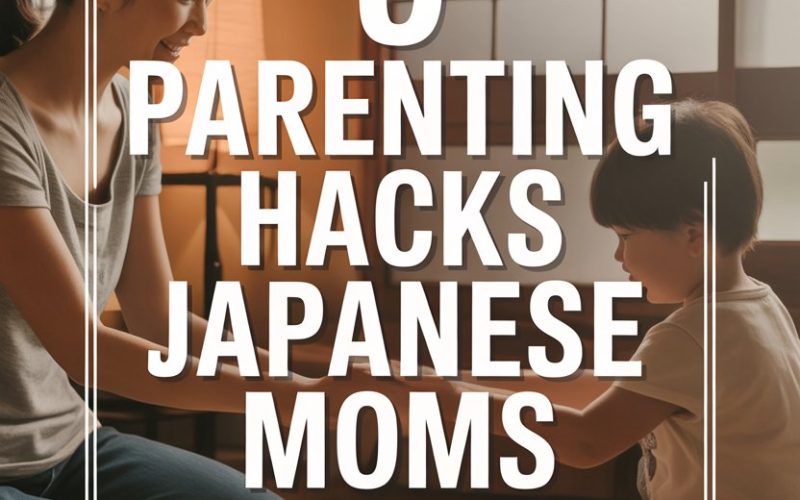Parenting comes with a universal accessory: bags under the eyes.
If you’ve ever found yourself hiding in the pantry just to eat a biscuit alone, you’re not alone—and Japanese mums, faced with the same daily mayhem, have crafted some pretty genius shortcuts.
Good news: most of their hacks won’t require you to master origami or cook rice seven ways before breakfast.
Ready for ideas you can actually use—even if the kids are already swinging from the curtain rods?
Here are five parenting hacks Japanese moms swear by, each one road-tested by generations of parents who value harmony, independence, and (let’s be honest) a little peace and quiet.
1. Morning Routines with Picture Schedules
Ever tried herding cats? Welcome to weekday mornings with toddlers. Japanese mums have long used visual schedules—simple picture charts that map out every step of the morning routine, from “wash your face” to “put on shoes.”
Instead of endlessly repeating yourself, point to the chart. It’s magic (well, almost).
These schedules aren’t just for the tiny crowd. Even primary schoolers benefit, since Japanese schools expect kids to remember their supplies and responsibilities from a young age.
A study by the National Institute for Educational Policy Research showed that Japanese children’s self-management skills are among the best in the world, partly thanks to these visual aids.
Try drawing your own chart (stick figures welcome) or printing one off Pinterest. Let your child check off each task as they go. Watch as your morning routine shifts from “Where are your socks?!” to “Check your chart, love.”
And if you’re the artistic type? A little washi tape and some cute stickers practically guarantee buy-in.
2. The One-Bite Rule That Actually Works
Battling picky eaters is a universal sport, but Japanese parents have a secret weapon: the ichibu taberu, or “just one bite” rule.
Instead of bribery or threats (which, let’s admit, rarely end in anyone eating broccoli), the rule is simple. Try one bite. No pressure for more.
Kids learn that new foods aren’t scary, and parents avoid turning the dinner table into a battleground. As nutritionist Yoko Shimizu explains, this low-pressure approach not only broadens palates, it reduces anxiety around mealtimes.
Over time, those “just one bites” add up to actual enjoyment—sometimes even enthusiasm. Imagine your child asking for seconds of spinach. Stranger things have happened.
Pro tip: Japanese mums often serve meals family-style, with several small dishes. If you’re introducing new foods, just add a tiny portion to the array. No lectures necessary; curiosity does the rest.
3. Chores Are for Everyone, Even Toddlers
Western parents sometimes marvel at Japanese kids heading off to school alone or tidying up after themselves in public spaces. This confidence starts at home, where even preschoolers pitch in.
Japanese families believe that chores foster responsibility and cooperation. Children as young as two wipe tables, fold laundry, or help set the table.
There’s even a popular TV show, Old Enough!, where toddlers run errands solo—cue equal parts awe and terror for parents elsewhere.
You don’t need to send your child out for groceries just yet. Try assigning one tiny job that matches their age and interests.
A three-year-old can sort socks (and will probably find it hilarious). School kids can help pack their bags or water the plants. Praise the effort, not just the result.
By making chores a normal family activity, you teach life skills and (bonus) reduce your own workload. Win-win.
4. Bento Box Lunches: More Than Just Cute Food
Bento boxes might look like an Instagram stunt, but in Japan, they serve a practical purpose. A well-packed bento offers balanced nutrition, encourages self-feeding, and makes lunch appealing even to the fussiest eaters.
Japanese mums often prepare colourful bentos with small amounts of many foods—think rice balls, cherry tomatoes, a slice of tamagoyaki (omelette), and a tiny pick.
Variety keeps things interesting and prevents the “but I don’t like anything” grumbles.
While your bento may never resemble a Pokémon character—and that’s perfectly fine—the concept works anywhere. Use silicone muffin cups to separate fruit, cheese cubes, and crackers in your child’s lunchbox.
Include something they love alongside something new.
Research from Kyushu University found that children who eat a wider variety of foods at lunch are less likely to be picky later on. The bento principle? Small, colourful, and a bit of fun.
5. Walking to School Builds Independence
In Japan, it’s not unusual to spot six-year-olds striding to school, yellow hats bobbing, schoolbags nearly as big as they are.
Parents in other countries often gasp, but this tradition is grounded in teaching independence, resilience, and community awareness.
Japanese neighbourhoods support this with well-marked crossings and watchful shopkeepers. The message: Kids are trusted to handle responsibility—and they rise to the occasion.
Even if your local area isn’t quite set up for solo school commutes, the principle can be adapted. Try letting your child lead the walk to the park, carry the keys, or manage simple errands beside you.
Research from the University of Tokyo found that a gradual increase in autonomy boosts confidence and problem-solving skills.
Start small. Trust them with a task that feels just slightly outside their comfort zone (and maybe yours). The sense of accomplishment is worth its weight in school badges.
Borrowing a Page from Japanese Moms
While every family is a little different—and no hack is a one-size-fits-all solution—these Japanese parenting tips have staying power for a reason.
They value routine, gentle encouragement, and the belief that kids are more capable than we sometimes think.
Will your mornings turn zen overnight? Unlikely.
But introducing a picture chart or inviting your toddler to “help” with chores just might buy you an extra five minutes—and maybe even a warm cuppa.
Now, if only someone could teach us how to fold laundry into perfect rectangles…





